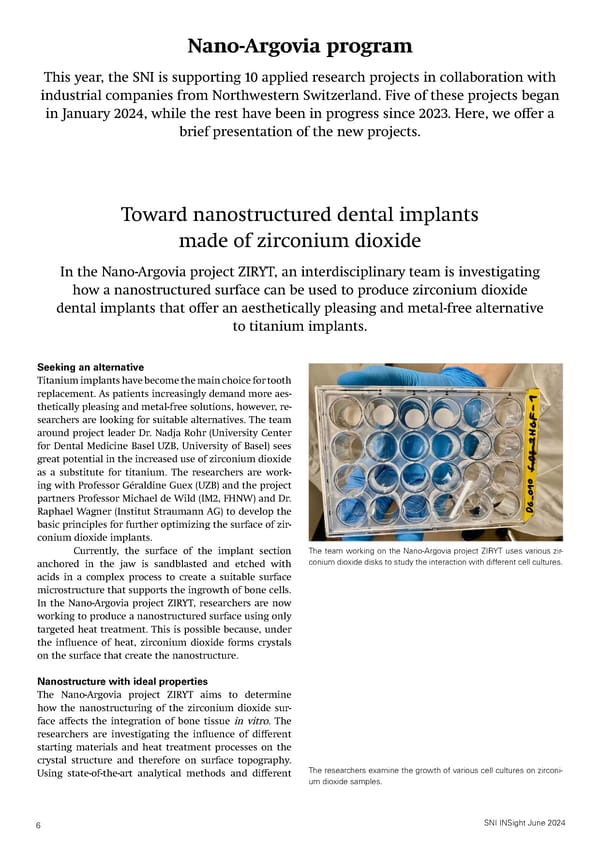Nano-Argovia program This year, the SNI is supporting 10 applied research projects in collaboration with industrial companies from Northwestern Switzerland. Five of these projects began in January 2024, while the rest have been in progress since 2023. Here, we o昀昀er a brief presentation of the new projects. Toward nanostructured dental implants made of zirconium dioxide In the Nano-Argovia project ZIRYT, an interdisciplinary team is investigating how a nanostructured surface can be used to produce zirconium dioxide dental implants that o昀昀er an aesthetically pleasing and metal-free alternative to titanium implants. Seeking an alternative Titanium implants have become the main choice for tooth replacement. As patients increasingly demand more aes- thetically pleasing and metal-free solutions, however, re- searchers are looking for suitable alternatives. The team around project leader Dr. Nadja Rohr (University Center for Dental Medicine Basel UZB, University of Basel) sees great potential in the increased use of zirconium dioxide as a substitute for titanium. The researchers are work- ing with Professor Géraldine Guex (UZB) and the project partners Professor Michael de Wild (IM2, FHNW) and Dr. Raphael Wagner (Institut Straumann AG) to develop the basic principles for further optimizing the surface of zir- conium dioxide implants. Currently, the surface of the implant section The team working on the Nano-Argovia project ZIRYT uses various zir- anchored in the jaw is sandblasted and etched with conium dioxide disks to study the interaction with different cell cultures. acids in a complex process to create a suitable surface microstructure that supports the ingrowth of bone cells. In the Nano-Argovia project ZIRYT, researchers are now working to produce a nanostructured surface using only targeted heat treatment. This is possible because, under the in昀氀uence of heat, zirconium dioxide forms crystals on the surface that create the nanostructure. Nanostructure with ideal properties The Nano-Argovia project ZIRYT aims to determine how the nanostructuring of the zirconium dioxide sur- face a昀昀ects the integration of bone tissue in vitro. The researchers are investigating the in昀氀uence of di昀昀erent starting materials and heat treatment processes on the crystal structure and therefore on surface topography. Using state-of-the-art analytical methods and di昀昀erent The researchers examine the growth of various cell cultures on zirconi- um dioxide samples. SNI INSight June 2024 6
 SNI INSight June 2024 Page 5 Page 7
SNI INSight June 2024 Page 5 Page 7